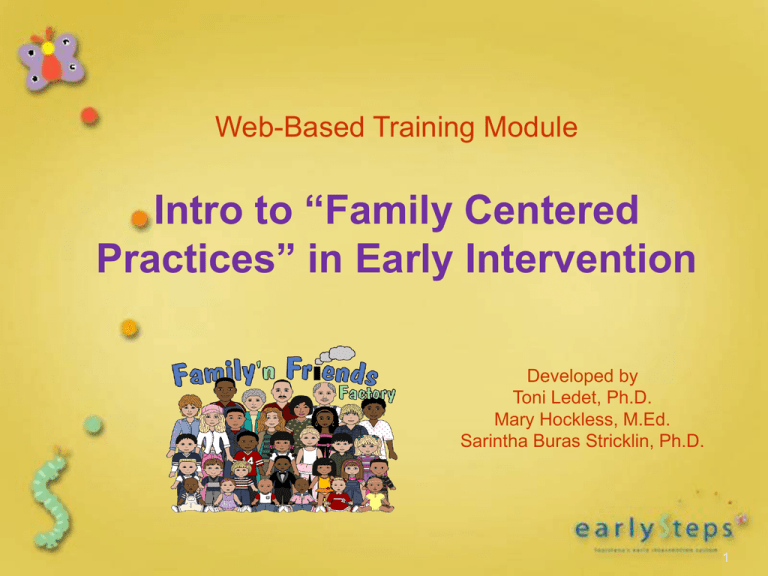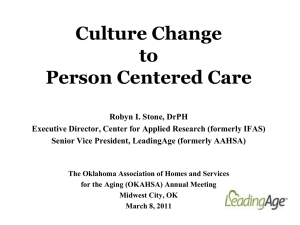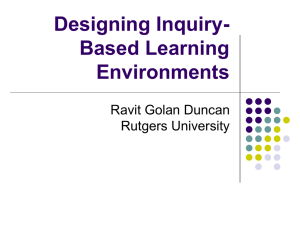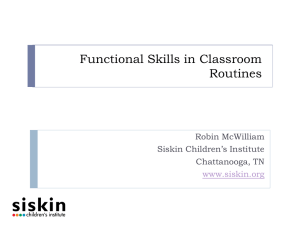Family Centered Practices - Louisiana Department of Health and
advertisement

Web-Based Training Module Intro to “Family Centered Practices” in Early Intervention Developed by Toni Ledet, Ph.D. Mary Hockless, M.Ed. Sarintha Buras Stricklin, Ph.D. 1 Collaborating Partners DHH Office for Citizens with Developmental Disabilities The Arc Baton Rouge, Children’s Services First Steps Referral and Consulting, LLC Innovations in Education, State Interagency Coordinating Council SICC Comprehensive System of Personnel Development and Program Components Committees Special Note: As part of participating in the Louisiana “SpecialQuest” Initiative, materials from the SpecialQuest MultiMedia have been incorporated throughout this module. (www.specialquest.org) 2 Learning Outcomes After completing this web-based training participants will Define “Family” and describe why this particular definition is important in their work in Early Intervention Describe the overall philosophy of family-centered practices including assumptions and principles Consider their own personal values, assumptions, and biases and how these affect their relationships with families Identify key features of family centered practices in Early Intervention Describe the rationale for implementing family centered practices in their work 3 Throughout this training module you will be asked to reflect on the information shared to consider how you might use it in your personal and professional lives. Opportunities for reflection support adult learning by helping participants internalize and generalize the content. You may want to have a journaling notebook to record your thoughts. 4 Post Exam Participants in the training session will complete a post exam. The results of the test will provide feedback on what you have learned from the module and will provide EarlySteps with data on the effectiveness of the instructional content in this training module. 5 View Video “Christopher’s Story” Individual Reflection View the video on the next slide and record in your journal, “Who is this family”? and “How would they define their family”? Now think about your family and record one word or idea that comes to mind when you think about your-self as a member of your family – Explore why you came up with that particular idea or word 6 Christopher’s Story 7 How Do We Define Family “…big extended, nuclear, multigenerational, with one parent, two parents, and grandparents. We live under one roof or many. A family can be as temporary as a few weeks, or as permanent as forever. Excerpted from the Report of the House Memorial 5 Task Force on Young Children and Families, New Mexico, 1990 8 Family We become a part of a family by birth, adoption, marriage, or from a desire for mutual support… A family is a culture unto itself, with different values and unique ways of realizing its dreams; together our families become the source of our rich cultural heritage and spiritual diversity. … Our families create neighborhoods, communities, sate and nations.” 9 Individual Reflection Reflect and record in your journal on how your culture values beliefs, and experiences may affect the work you do with children and families 10 Culture “The way of life of a group of people, including shared views of the world and social reality, values, and beliefs, roles and relationships, and patterns or standards of behavior (such as communication styles).” (Chen, et al., 1998) 11 Culture “Cultural features are linked to a sense of shared ancestry and continuity with the past and can be based on race, ethnicity, nationality, geographic location, as well as other dimensions of diversity.” (Chen, et al., 1998) 12 Elements of Culture Culture includes a group’s shared values, beliefs, behaviors, preferences, verbal and nonverbal communication styles, and relationship patterns. 13 Individual Reflection Reflect on the following questions and record your thoughts in your journal What stands out for you in the definition of culture and the elements identified? Do you have any elements you think need to be added? What implications might these ideas have on the process of building relationships? 14 Effective Relationships With Families Depend Upon Open and honest communication Understanding, acceptance and respect for values and belief’s different from one’s own On-going self-reflection Commitment to the relationship “Actively Listening” to the family 15 Families Families and service providers bring their own personal and family culture to their relationship. 16 Part C of IDEA and Family Centered Practices Part C of IDEA mandates the central role of the family throughout all services. A goal of Part C is to “enhance the capacity of families to meet the special needs of their infants and toddlers with disabilities” (Section 631). Subsequent sections of the law reference the inclusion of the family in all aspects of the IFSP. The law emphasizes that the process is “family directed” drawing a clear distinction between a less active role and one in which they assume the lead. Louisiana’s Early Steps program supports this premise through its mission and philosophy outlined in the Practice Manual. (see Mission and Philosophy below in notes section) 17 How do we define Family Centered Practices? Definitions for “Family Centered Care or Services” started in the area of health care, and exist in the fields of social services, child welfare, developmental disabilities, and mental health as well as Early Intervention The Beach Center (Allen & Petr, 1995) highlighted three core elements of family centered services 1. The family as the unit of attention 2. Informed family choice 3. A family-strengths perspectives 18 Definition of “Family Centered Service Delivery” "Family-Centered service delivery, across disciplines and settings, recognizes the centrality of the family in the lives of individuals. It is guided by fully informed choices made by the family and focuses upon the strengths and capabilities of these families." (Allen & Petr, 1995) 19 Characteristics of Family-Centered Practices (Turnbull and Turnbull, 2001) Include families in decision-making, planning, assessment and service delivery at all levels Offer and respect families' choices regarding participation Characteristics of Family-Centered Practices (Turnbull and Turnbull, 2001) Develop services for the whole family (not just the child) Are guided by families priorities for goals and services 20 Underlying Assumptions of Family Centered Principles or Practices: All people are basically good. All people have strengths. All people need support and encouragement. All people have different but equally important skills, abilities and knowledge. All families have hopes, dreams and wishes for their children. Families are resourceful, but all families do not have equal access to resources Families should be assisted in ways that help them maintain their dignity and hope. Families should be equal partners in the relationship with service providers. Providers work for families. 21 Guiding Principles and Practices for Delivery of Family Centered Services The ongoing “work’ between families and providers is about identifying family concerns (priorities, hopes, needs, goals, and wishes), finding family strengths, and the services and supports that will provide necessary resources to meet those needs. Families are active participants in all aspects of services. They are the ultimate decisionmakers in the amount, type of assistance and the support they seek to use. Efforts are made to build upon and use families’ informal community support systems before relying solely on professional, formal services The overriding purpose of providing family-centered help is family “empowerment, ” which in turn benefits the well-being and development of the child. Providers across all disciplines collaborate with families to provide resources that best match what the family needs. Support and resources need to be flexible, individualized and responsive to the changing needs of families. Mutual trust, respect, honesty, and open communication characterize the family-provider relationship. 22 Provider Practice 23 Provider Empower Families 24 Provider involve families at every level of decision making 25 Provider assist families in developing informal community support systems. 26 Provider teams working together with families to meet family needs. 27 Family/provider relationship require building mutual trust and respect. 28 Individual Reflection Reflect on the Guiding Principles and Practices for Delivery of Family Centered Practices Record in your journal one principle that you feel is your strength and what practices you use that reflect this principle Record in your journal one principle that you would like to improve in and what practice you might implement 29 Family-Driven Planning Family-Centered Services involves encouraging family-driven planning Creating partnerships between professionals and families Sharing pertinent information and resources Begins with the initial contact with families Involves open-ended discussions about the family’s concerns, priorities, and resources (CPRs) 30 When Family-Driven Planning Occurs Families make decisions Partnership of communication and collaboration with the family Participation is encouraged Respect for the differing levels of participation chosen by each individual family 31 Forming Successful Partnerships with Families Reflect on your own values and perceptions Earn the families’ trust through interactions that are respectful and confidential. Make an effort to understand the family Respect cultural differences Forming Successful Partnership with Families Focus upon a family’s strengths Allow families choices Strive for positive outcomes 32 Focus On Family Strengths 33 View Video “Embracing Possibilities” Individual Reflection Reflect on the video on the next slide Record your thoughts about how forming successful relationships was reflected in the video. 34 Embracing Possibilities 35 Family-Directed or Family-Based Assessment Information (resources, strengths, and concerns) that becomes the foundation of their individual plan Families choose to share information Includes as much or as little as the family chooses to share Can occur in a variety of ways (e.g. interviews, instruments, conversations, drawings) Can come from a number of family members 36 Communication Strategies Active Listening Paraphrasing or Restating Giving concrete example Using open-ended line of questioning and inquiry 37 Communication Strategies Self awareness and Reflection Focus on the positive/Avoid blame Sharing perceptions using family-friendly language 38 Routines-Based Assessment Assessment process that is unlike the disciplinespecific, standardized assessment measures used for eligibility purposes Enables teams to identify functional, individualized goals Providers identify the skills or behaviors a child must possess to get through daily routines successfully 39 Routines-Based Interview (RBI) Families and professionals decide which of the following are needed to make a particular routine successful: Changing the behavior of the child Changing the environment Changing the expectations for the child 40 “Routines-Based Interview” McWilliam (2001) identifies the following 5 key steps in a “Routines-Based Interview” Prepare the family (and class-room staff, if needed) to report on routines Family reports on their routines What are Routines? Interviewer reviews concern and strength areas Family selects outcomes Family puts outcomes into priority order 41 What Are Routines? 42 Routines Based Interview Helping families develop their outcomes 43 Writing Functional Outcomes Based on Routines Functional Assessment Information Functioning in Daily Routines What’s needed for child to be able to participate, learn from, and enjoy daily routines Outcomes 44 Individual Reflection Review an IFSP of a child you are currently a provider for and determine if family outcomes are included Using that IFSP record in your journal how using RBI might affect your practice and the outcomes developed for families Record in your journal how you might begin to implement the practices of RBI and writing more functional family outcomes 45 Closing Thoughts The information shared in this training module was designed to introduce providers to the principles of Family Centered Practices in Early Intervention and to provide some strategies for implementing these principles into daily practices. As we move toward putting into practice what we have learned, always consider out definition of “Family”. 46 Next Steps Every provider of every service in EarlySteps should use the practices from this module in their service delivery to children and families. 47 References and Resources “References and Resources” for this training module can be found below in the notes section. 48 Thank You for Participating in the EarlySteps Web-based Training Module: Intro to “Family Centered Practices” in Early Intervention! Funding for training provided by the LA Department of Health and Hospitals, Office for Citizens with Developmental Disabilities, EarlySteps 49









